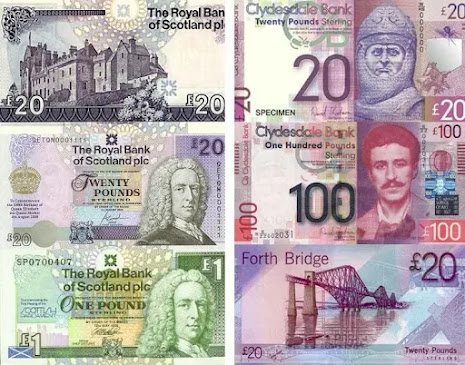The currency of the United Kingdom , and therefore also the Scottish one, is the pound sterling (£) , or Great Britain Pound (GBP).
In English it is known as pound , and you will see that the symbol is always written before the number . For example, £10 is ten pounds , or pounds.
It is very rare to find places where they accept euros, even in the most touristy areas, so before traveling to Scotland you will need to change currency.
Sterling Coins
The pound sterling, or Great Britain Pound (GBP), is divided into 100 pence . The pound sterling coins are the same throughout the UK.
They are the penny (a penny) , the pence (pence, in the plural) and the pound (the pound sterling) .
When paying in a store, you'll see that pennies are also called p (pronounced like the letter P in English, 'pee'). The circulating pound coins are :
- 1 penny (£0.01 – 1p) – 1 cent or penny
- 2 pence (£0.02 – 2p) – 2 cents or pence
- 5 pence (£0.05 – 5p) – 5 cents or pence
- 10 pence (£0.10 – 10p) – 10 cents or pence
- 20 pence (£0.20 -20 p) – 20 cents or pence
- 50 pence (£0.50 – 50 p) – 50 cents or pence
- 1 pound (£1) – 1 pound. It is called quid colloquially.
- 2 pounds (£2) – 2 pounds
Various coins of pounds and pence
Scottish Banknotes
In addition to the banknotes printed by the Bank of England, there are three Scottish banks that issue their own banknotes : the Royal Bank of Scotland, the Bank of Scotland and the Clydesdale Bank.
There are £5, £10, £20, £50 and £100 , and, as a curiosity, the Royal Bank of Scotland also issues one pound (£1) notes, although in small editions.
If you change money before traveling to Scotland, the banknotes you will be given will be English ones, but in Scotland you will probably get your change back in Scottish pounds.
Pounds issued by the banks of Scotland
The New Scottish Banknotes (2016)
Like the Bank of England, Scottish banks are also gradually changing their notes over the next few years to polymer notes.
- The new Scottish £5 notes entered circulation in 2016.
- The £10 ones came into use at the end of 2017.
- The new £20 notes will be introduced in 2020.
How to pay in Scotland
In Scotland, as in the rest of the UK, it is common for any transaction, no matter how small, to be paid for by card . The only places that have a minimum to pay by card are some small shops and B&Bs.
On the street it is not difficult to find cashpoints (ATMs) , often next to supermarkets. But, in general, the commission to withdraw money with a card from another country at an ATM is higher than the price of paying with a card directly (in this case, the only money you "lose" is for the change that your bank applies , which can be more or less faithful to the real change of the day).
It depends on the amounts of money you need and, of course, the commission from your bank for withdrawing money in foreign currency , so it is always advisable to go to your branch to find out before the trip.



Comentarios
Publicar un comentario